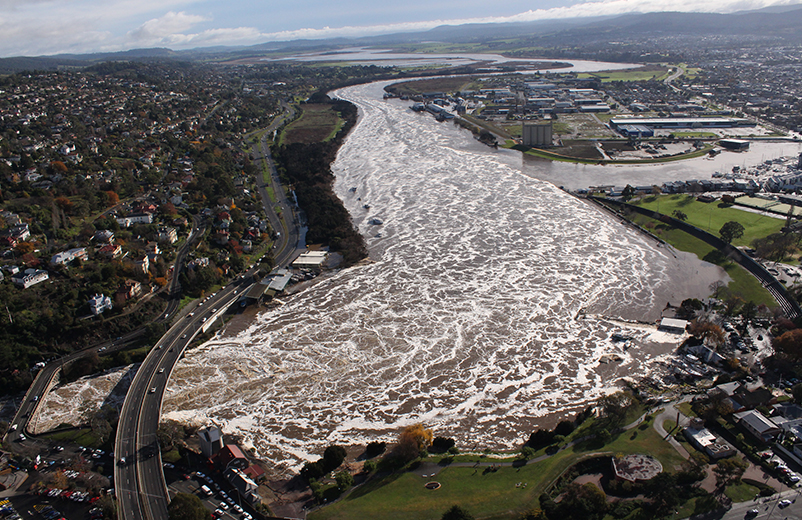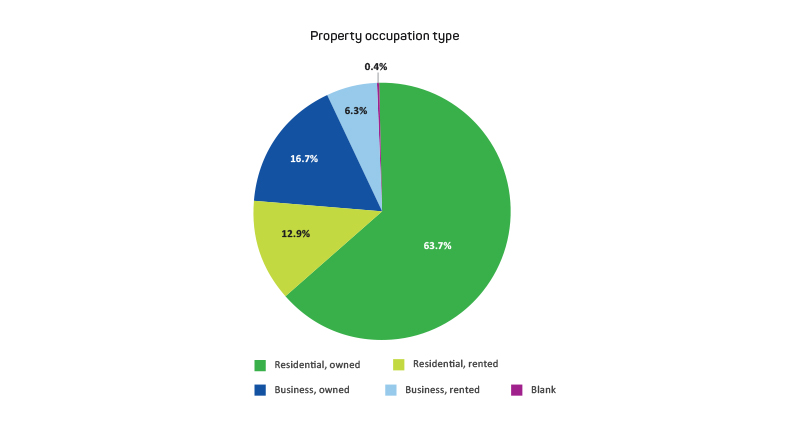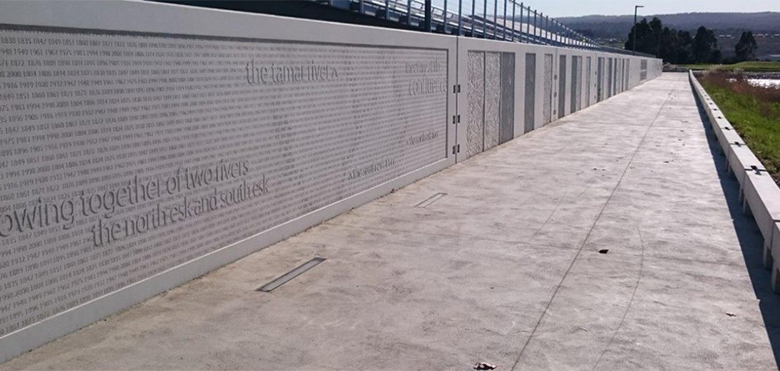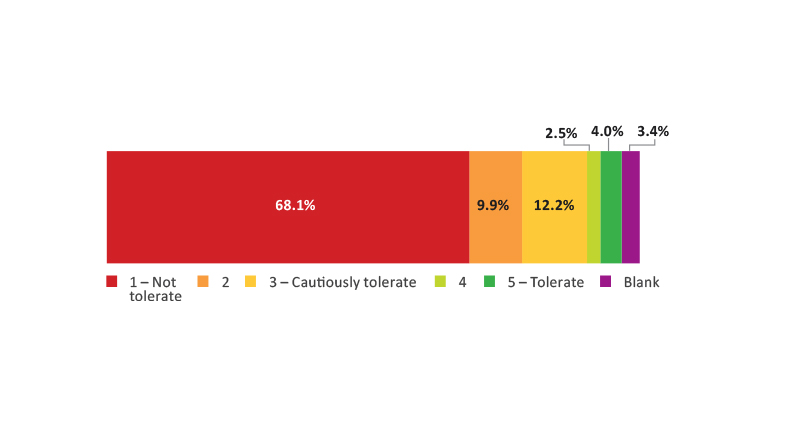Levees are used in Australia and across the world as a structural means to reduce flood risks. However, people protected by levees can develop a false sense of security believing that the levee is fail-proof or might only fail in extreme flood events. This optimism can lower flood preparedness levels and lead to increased urban development in flood-prone areas. This can magnify flood risk behind the levee—a phenomenon known as the ‘levee paradox’ or ‘levee effect’. This article analyses the results of a community survey conducted with residents and businesses located behind the levees in Launceston, Tasmania. The survey revealed a widespread low level of flood-risk awareness and elevated optimism about the protection afforded by the levee system. However, there were no significant and direct relationships between the possible levee paradox causal factors and the low levels of preparedness identified. This does not rule out the levee paradox, as more complex psychological interrelationships could be involved. Emergency management planning should consider the high proportion of people (over one-third) who stated they would require assistance during a flood in the Launceston levee-protected areas.
Introduction
The NSW State Emergency Service (2022) defines a levee as ‘…a man-made structure built to contain, control or divert the flow of water in order to provide protection to towns and/or agricultural land from flooding’. A levee is a structural flood mitigation option used to reduce the exposure of the community to flood hazard. It is one of a suite of flood-risk management options used across Australia (Australian Institute for Disaster Resilience [AIDR] 2017) and elsewhere in the world.
According to Managing the Floodplain: A Guide to Best Practice in Flood Risk Management in Australia handbook (AIDR 2017), levees have a ‘high’ ability to address flood risks in existing and new development areas. The guide states:
For events up to their design flood, levees can provide significant reductions in damage and allow communities to function during long-duration floods, provided the structural integrity of the levee is not compromised. (AIDR 2017)
However, the handbook acknowledges that:
…measures such as house raising and levees reduce risk to property but are known to have an adverse impact on perceived risk to life because people incorrectly assume that property protection measures have eliminated flood risk. (AIDR 2017, p.46).
This can lead to the ‘levee paradox’ or ‘levee effect’ where community preparedness declines and urban development increases (Smith 2003) due to optimistic risk perception related to the levee protection. As a result, levee construction may, paradoxically, result in increased consequences if an extreme flood event occurs.
The existence of the levee paradox has critical implications for emergency management and land-use planning. Emergency managers need to work with communities that may have an optimism bias related to flood risk provided by the levee and who will most likely display low levels of preparedness and an unwillingness to respond to flood warnings (e.g. to evacuate). Land-use planning should rely on a well-documented risk assessment exercise, rather than on the way the community perceives such risk because of the levee’s protection.
There has been considerable research into the levee paradox and associated psychologies as scoped by Di Baldassarre and co-authors (2018). For example, De Marchi and Scolobig (2011) conducted social research with reference to 4 communities in north-eastern Italy. They found a widespread false sense of security induced by the presence of (often significant) flood-risk reduction works. Similarly, research by Ludy and Kondolf (2012) in the Sacramento Valley (USA), found that people protected by levees were not motivated to undertake private precautionary measures and, as such, were more vulnerable.
Multiple factors drive risk perception and the adoption of protection measures. According to Di Baldassarre and co-authors (2018), ‘This leads to dissimilar outcomes in different contexts’. For example, Botzen, Aerts and van den Bergh (2009) found that people in The Netherlands were mostly unaware of the protection level of their levees, even though such a protection level is extremely high. Direct flood experience has also been identified as a significant determinant of increased community risk perception (Wachinger et al. 2013).
Levees are widely used in Australia and there are 116 levees in NSW alone (NSW State Emergency Service 2022). However, there has been little social research conducted to examine the psychological effect of levees and if the levee paradox exists. One study was conducted by Gissing and co-authors (2018) in Lismore, NSW. For this research, a telephone survey of business owners in the Lismore central business district was conducted resulting in 50 responses from a total of approximately 400 businesses. Evidence of the levee paradox was found:
The construction of the levee in 2005 has had some impact on the perception of flood risk. This is evidenced by the number of respondents who believed the levee provides more protection than is allowed for in its design. In addition, respondents believed it is now less important to be prepared for floods than prior to the construction of the levee. (Gissing et al. 2018)
In 2021, a survey was undertaken in Launceston as part of a risk-based study to determine appropriate flood development controls and strategic land-use planning. This article analyses the results of that survey conducted with residents and businesses behind the levees in the city. While the survey was primarily designed to collect input data for a flood-risk assessment and mapping exercise, its results provide a unique dataset to gain insight into the psychological effects of the levees and if a levee paradox exists, at least from a social perspective.
Launceston levees
Launceston is Tasmania’s most populous municipality and has been recognised as a flood-prone area since a major inundation in 1828. It has experienced 36 significant floods since records began, with the 1929 flood considered to be the worst (Fullard 2013).
This flood risk is primarily due to the location and topography of Launceston’s lower suburbs, Inveresk and Invermay, which are located at the confluence of the North Esk, South Esk and Tamar rivers (Atkins & Vince 2009).
Ways to protect Launceston from flooding were considered following the 1929 flood. In 1955, the Launceston Flood Protection Authority was established to progress this work. Construction commenced on a levee system in the mid-1960s with the project funded by the City of Launceston Council and the Tasmanian Government. A new Launceston Flood Authority was established in 2008 to design, construct and maintain existing and new flood levees.

Floodwaters from the South Esk River enter the kanamluka / River Tamar estuary on 8 June 2016.
Image: City of Launceston Council
Currently, there are approximately 3,000 residential and commercial properties protected by the levee system (Figure 1).
Modelling shows that the levee system would be overtopped in a 0.5% Annual Exceedance Probability (AEP) or 1-in-200-year flood (BMT 2019). However, due to climate change, by 2050 it would be overtopped in a 1% AEP or 1-in-100-year flood (BMT 2019).

Figure 1: Levees in Launceston currently protect 3,000 residential and commercial properties.
Methodology
A community survey was designed to assess levels of community resilience to floods in Launceston’s levee-protected areas. Questions were prepared to investigate 4 indicators:
- Risk awareness and perception: These questions assessed if people had a correct understanding of their flood risk. Therefore, they focused on respondent perceptions of whether their home or business could flood and the extent of protection provided by the levee system.
- Capability to absorb the impacts of flooding (i.e. tolerability): These questions involved a self-assessment by respondents to assess the extent to which they thought they could handle a flood on their property without long-term, intolerable consequences.
- Preparedness: These questions assessed the preparedness of businesses and households for flooding to identify ways in which residual flood risks are managed at the property level. The questions focused on whether there was a flood insurance policy for the property and if a flood emergency plan existed.
- Emergency management and social capital: These questions required respondents to self-assess their capability to effectively respond to a flood emergency. Questions assessed if the respondent would require assistance, whether they had somewhere to evacuate to, how well they could keep themselves safe and whether they would help others during a flood.
The survey was mailed to all residential and commercial addresses in the levee-protected areas of Launceston. Respondents could submit their completed survey by return post, email or online.
The research was conducted in line with the principles in the National Statement on Ethical Conduct in Human Research (National Health and Medical Research Council 2015).
Results
A total of 540 responses were received, a response rate of approximately 19%. Figure 2 provides a summary of the property occupation background (residential vs business, owner vs renter) of the respondents.

Figure 2: Property occupation type of survey respondents.
Risk awareness and perception
The survey indicated that 57% of respondents from the levee-protected areas were aware that riverine flood waters could enter their yard or driveway, while 39% believed that they could not. Similarly, 53% of respondents were aware that the flood waters could enter their home or business, while 42% believed they could not (approximately 4% were unsure).
Interestingly, businesses were more aware of the risk of flooding than occupants of residential properties. Only 48% of respondents for residential properties thought that their home could be at risk of flooding, whereas 70% of respondents for businesses were aware that their business could flood. A chi-square test was performed to test the relationship between property type and occupant awareness of the flood risk to the building. The test of independence showed that there was a significant relationship between the 2 variables, χ2 (2, N=474) = 15.8, p<.001.
The survey revealed a widespread ‘optimism bias’ in the perceptions of respondents regarding the extent of flood protection afforded by the levees. Respondents underestimated the residual flood risk by overestimating the protection provided by the levees. Only 15% of respondents identified the correct level of levee protection, while 63% thought the levees provided protection in floods above the level that they would be overtopped (8% thought that the levee provided protection in all floods).
Respondents who knew that their yard could flood were twice as likely to correctly identify the protection of the levees as respondents who thought their yard could not flood or were unsure. A chi-square test was performed to test the relationship between whether a respondent was aware that floodwaters could enter their yard or driveway and whether they correctly identified the extent of levee protection. The relationship was found to be significant, χ2 (1, N=468)=9.29, p=.002. However, even among those who knew the flood risk to their yard, awareness of the protection provided by the levees was low, with only 19% correctly identifying the extent. Similarly, respondents who knew the flood risk to their home or business, were twice as likely to correctly identify the levees’ flood protection, although among this group, only 20% correctly identified the extent of levee protection.
Residents who rented their homes were particularly unaware of their property’s flood risk, with only 10% correctly identifying the flood risk and 44% indicating that they were unsure of the extent of flood protection afforded by the levee system.

The Invermay Levee in Launceston.
Image: City of Launceston Council
Flood tolerability
Figure 3 shows that respondents generally had a low tolerance for floodwaters entering their property. Sixty-eight per cent of respondents indicated that they would not tolerate floodwaters entering their home or business (i.e. above-floor flooding), while 12% indicated they would cautiously tolerate such an event and only 4% believed they could tolerate it.

Figure 3: The tolerability to property flooding by respondents.
A chi-square test was performed that showed the respondents who believe that floodwater could enter their home or business are less likely to think they can tolerate the floodwaters than those who believe their building cannot flood, χ2 (4, N=439)=31.9, p<.001.
Community preparedness
Two aspects of flood preparedness were measured in the survey being:
- uptake of flood insurance
- preparation of a written flood emergency plan (with related knowledge of evacuation routes and preparation of emergency kits) as encouraged by the State Emergency Service (State Emergency Service Tasmania 2022).
Flood insurance is an accepted preparedness indicator, offering the transfer of a risk from one party to another for the payment of a premium (Surminski & Thieken 2017). Its adoption in Australia is contingent on factors including affordability, risk perception and perceived social expectations (Lo 2013).
The survey showed that the uptake of flood insurance was generally low in the levee-protected areas of Launceston, with 41% of respondents indicating they had an insurance policy for their property, 29% indicating that they did not and 27% were unsure. This level of uptake of flood insurance in the Launceston levee-protected areas is far lower than Australia’s national average, which is 93% (Insurance Council of Australia 2016). However, most respondents (80%) were aware of flood insurance.
Even fewer respondents (11%) indicated that they had a written flood emergency plan for their property. While only 8% of residential properties surveyed had a written flood emergency plan, 21% of businesses had a plan. Awareness of flooding, risk perception and length of occupancy do not appear to be by themselves causes of this low level of preparedness.
Chi-square tests conducted to test potential relationships between awareness of whether the house or building could flood and flood insurance uptake, and with written plan preparation indicate that the relationships are not statistically significant at p<.05 (χ2 (2, N=451)=1.18, p=.55 and χ2 (2, N=451)=5.34, p=.069, respectively).
Similarly, chi-square tests of the relationship between perceptions of the extent of flood protection from the levee and flood preparedness suggest that the data do not provide strong evidence for a significant relationship. There was also no strong statistical relationship between property occupation length (and indirectly flood experience) and the preparedness behaviours.
Emergency management and social capital
Approximately 35% of respondents indicated that they would require assistance from others during a flood. Many stated that they require assistance due to limited mobility related to age, ill health or disability, while others lived alone and do not drive or do not have access to transport. Ironically, when asked to rate their ability to keep themselves safe, only 6% of respondents rated their ability as ‘not good’ and 3% as ‘poor’.
The most pressing concern among these respondents was that they would require assistance for evacuation, but many were also worried they would need help evacuating their pets. Several other forms of assistance were identified including assistance in securing property (by sandbagging, removing items or raising items), the provision of accommodation and food, assistance in clean-up following the flood and emotional support.
Many respondents indicated that they would rely on assistance from the community, including friends, family and neighbours. Several, particularly those who stated they had no family or friends nearby, expected that they would require assistance from the State Emergency Service, the local council or other emergency services and some indicated they would need assistance from the National Disability Insurance Scheme or insurance companies in flood recovery.
A smaller proportion of business respondents (27%) indicated they would require assistance during a flood. The most common form of assistance was moving inventory and equipment, followed by assistance with sandbagging and with clean-up post-flood. Business respondents indicated they would rely on local authorities for assistance, such as the State Emergency Service, the City of Launceston Council and other emergency services. Some business respondents indicated that they would need help from staff. The reliance on family and friends was far less pronounced than among residential respondents.
Respondents were more likely to rate their ability to cope with a flood as ‘excellent’ if they believed that the levees would protect them in all floods. A chi-square test found a significant relationship at p<.05 between a respondent’s self-rating and whether they believed there was a residual flood risk despite the levees, χ2 (5, N=371)=14.5, p=.013. Respondents who thought that the levees afforded protection from all flood events were more likely to rate their ability to keep themselves safe as either ‘excellent’ (45%) or ‘poor’ (8%) than respondents who thought there was a residual flood risk (‘excellent’, 27%; ‘poor’, 2%).
This research suggests that social capital levels are high in the levee-protected areas of Launceston, with 83% of respondents indicating that they would help others in a flood. Of concern, this includes 33% of respondents who indicated that they would require assistance during a flood. It is likely that the responses to the question about helping others reflects more of a willingness to do so and not necessarily a capability to do so.
Many respondents indicated they would act as first responders to help neighbours, particularly to help elderly people or other neighbours with low mobility. Respondents also indicated they would help their friends, family, tenants, children, people in distress, people with no transport, local residents, local businesses and strangers. Numerous respondents said they would help anyone who needed it. The main activities that respondents indicated they would assist others with were evacuation, including providing transport and assisting in the evacuation of pets, and with moving items, furniture and business inventory or equipment. Several respondents stated they would arrange, pay or provide accommodation for others or they would provide food and would help with clean-up after the flood.
Discussion
Although there was a widespread low level of flood-risk awareness and elevated optimism towards the protection afforded by the levee system, there were no significant direct relationships between these potential levee paradox causal factors and the low levels of preparedness that were tested. Although previous flood experience was not directly tested as a causal factor, length of occupancy was tested and found to not be a contributing factor to the low preparedness levels.
This analysis does not rule out potentially detrimental effects of psychological perspectives towards the levee system. The hallmarks of the levee paradox are in place with low preparedness levels and an overriding high-coping appraisal and perceived self-efficacy, even though many people are highly vulnerable (e.g. older adults, people with disability) and would require some type of assistance including from emergency services.
Research shows that there is a complex interrelationship or nesting of determinants of flood preparedness (Grothmann & Reusswig 2006; Lindell & Perry 2004; McIvor, Paton & Johnston 2009). From the survey, there was a strong relationship between awareness of flood risk and correct perception of the levee protection. There could be a cumulative effect of these and other factors influencing the low preparedness levels including the demographics of the study area (e.g. older age population).
The survey was designed to provide input to risk assessment mapping and only 2 preparedness indicators were tested, which limits the ability to determine a local levee paradox. Further research is required to examine other indicators (for example, knowledge of evacuation routes, preparation of emergency kits, willingness to raise items before a flood) to ascertain if preparedness is low.
The levels of flood land-use planning controls can also influence preparedness levels. Planning controls communicate flood risk to landholders (Grech 2011) and, possibly, the current land-use planning regime contributes to the low preparedness levels. The communication of flood risk through land-use planning should be improved as a result of the risk-based approach used in the study.
Local emergency management organisations can help raise preparedness levels through ongoing community flood education programs (Dufty 2020). The importance of flood insurance and having a written flood preparedness plan should be stressed as well as other aspects of preparedness such as evacuation planning and having a property emergency kit. For businesses, continuity planning that includes flood emergency planning should be promoted.
Emergency management planning should consider the high proportion of people (over one-third) that require assistance in the Launceston levee-protected areas. Many of these people say they will depend on emergency services for this assistance. Most people will not tolerate flooding and could be highly anxious if the levee system was compromised. The high number of community members who say they will assist others, including vulnerable people, should be harnessed in emergency management planning.
Conclusion
This research gives insight into the psychological interrelationships related to living behind the levees in Launceston. Although a strong and direct relationship was not identified between some of the potential determinants of the levee paradox, the low levels of preparedness identified should be addressed. Emergency management planning should also consider the high levels of vulnerable people in the area.
The research was designed to provide input to a flood-risk assessment to determine appropriate future land-use development controls and was limited in testing a range of preparedness indicators and, thus, the possibility of a levee paradox. However, it does give insight into risk perceptions, tolerability and proposed response behaviours of those living and working behind the Launceston levee system and will be useful to emergency managers.
The possible adverse psychological effects of levees should be researched in Launceston as well as other highly flood-prone areas in Australia. With several hundred levees across the nation, there seems little understanding of how and why people prepare and respond to flooding if the local levee overtops or fails. Levee compromise is a form of dam break and can cause slow onset riverine flooding that converts to flash flooding as water rushes through adjacent settlements. The little warning time and consequences for people who are poorly prepared can lead to perilous situations.


